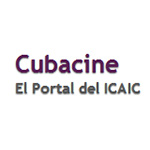 “Nuestro objetivo final es nada menos que lograr la integración del cine latinoamericano.
Así de simple, y así de desmesurado”.
“Nuestro objetivo final es nada menos que lograr la integración del cine latinoamericano.
Así de simple, y así de desmesurado”.
Gabriel García Márquez
Presidente (1927-2014)


-

Qué tan lejos queda EcuadorPor Dean Luis ReyesMucho se ha comentado en Ecuador la opera prima de la realizadora Tania Hermida, Qué tan lejos. Esta producción independiente, que tomara varios años de preparación a su directora, ha provocado una recepción entusiasta y una respuesta en taquilla inesperada. Y ello es curioso para una historia pequeña, road movie sin apenas peripecia física, que rehace en otra cuerda el examen de conciencia y el “viaje a la semilla”.
La anécdota de Qué tan lejos reúne a tres personajes, dos mujeres y un hombre; las primeras, una joven turista española y una adolescente quiteña; el otro, un individuo no tan joven. Todos coinciden en el camino de la capital ecuatoriana a Cuenca, cuando un cierre de vías a causa de una protesta de grupos indígenas, les obliga a seguir su rumbo por sus propios medios. El diseño de personajes no obvia la intención alegórica: la chica española se llama Esperanza; la ecuatoriana, menos entusiasta que aquella, se presenta como Tristeza. La primera, viene con sus guías para turistas y su carácter curioso, a por lo exótico del rumbo escogido; la segunda, retraída y poco sociable, de vocación intelectual, viaja a impedir la boda de su novio con otra mujer. Para cerrar la tríada, Jesús es el nombre del tercero del grupo, quien viaja apurado para no perder la ceremonia del sepelio de su abuela, cuyas cenizas lleva consigo.
Las road movies son un topos predecible: los personajes atraviesan el paisaje, lo transforman con su presencia, mientras éste y los acontecimientos que en torno al mismo se producen, se les atraviesan en el carácter. El saldo es la transformación, en medio del movimiento, de las certidumbres y las nociones tenidas por seguras. Eso sucede en este viaje: a Esperanza se le revela una idea más compleja del Ecuador; Tristeza descubre que la vida no tiene un solo rumbo; Jesús, después de oficiar como especie de balance y rasero de humanidad entre ambas, desaparece de improviso.
Sin embargo, el viaje iniciático de las mujeres se verifica en nosotros, los espectadores de su peripecia. Asistimos como copilotos al desfle de identidades, localidades reales, etnicidades y rasgos culturales: el Ecuador multiétnico y pluricultural. Los datos en torno al país y su sociedad aparecen disueltos en la vida cotidiana de los personajes, y a través de ellos se visibiliza un carácter, retazos de aquello que suele denominarse identidad. La típica historia de descubrimiento y revelación, así como de tránsito hacia la madurez, consigue en nuestra mirada un panorama diverso del país y su gente.
Esta obsesión por la identidad que acompaña al cine latinoamericano, y que se ha desplegado en la obra de los jóvenes realizadores desde una oblicuidad que recurre a los tópicos tradicionales de representación artística de las realidades sociales de sus países, fue un superobjetivo de la Hermida. En una entrevista, declaraba: “Si bien es innegable que tenemos conflictos sociales y económicos profundos, también es innegable que somos mucho más complejos como sociedades que simplemente el país de la pobreza o el narcotráfico. Tenemos muchas otras cosas que contar, pero esas son las propuestas que mejor venden afuera. Yo me niego a hacer un cine para la mirada ajena. Para mí, lo más importante es mi propia mirada, y en esa mirada cabe mucho más que esos problemas (...) Pero los pongo en otra perspectiva. Pongo en primer plano otras cosas más personales”.
Esta dimensión banal, intrascendente, del reflejo de las realidades sociales latinoamericanas, encuentra en Qué tan lejos el trabajo con una historia diminuta, pero contada con el suficiente desembarazo y naturalidad como para hacerla interesante a la vista de todos. La dimensión humana del presente ecuatoriano, con sus conflictos políticos, culturales y económicos, bajo los cuales se debaten los dramas efímeros de la existencia individual, saltan ahora desde el sistema de personajes, desde lo particular, mientras que aquella generalidad que abarca en forma de todo ese universo, queda como paisaje, comentario suelto, conversaciones sesgadas y apuntes sin importancia.
La búsqueda de la felicidad y la realización del yo individual parece convertirse en la nueva militancia de estas obras, las cuales, por otra parte, muy a menudo se pierden en circunloquios y dudan en la búsqueda de su consumación. Qué tan lejos sufre de esa divagación tan habitual en torno a cómo cerrar el relato, al tiempo que debilita en lo anecdótico la agudeza con que desde el inicio perfila las sicologías de sus personajes. Igualmente, la perspectiva femenina evidente suele dirigir una mirada esquemática hacia los personajes masculinos. Además, la película pierde fuerza, el ritmo se agota hacia las postrimerías y aparecen subrayados concluyentes y un exceso de verbalismo que pudo podarse con una atención más detenida al trabajo con la dimensión visual del relato.
No obstante, el debut de la egresada de la Escuela Internacional del Cine y Televisión de San Antonio de los Baños, es bien auspicioso. Su película, que obtuvo el Zenith de Plata del Festival Internacional de Cine de Montreal, anuncia, como tantas otras en los últimos años en América Latina, la posibilidad de gestionar un cine con trazas autorales que al mismo tiempo consiga esa dimensión popular, entretenida y comprometida. La madurez cabe en la dimensión enorme de la posibilidad. Y en las circunstancias que, como el paisaje, propicien o impidan esa mutación durante el viaje: al final de los créditos, Qué tan lejos saluda la nueva Ley Nacional de Cine ecuatoriana. Acaso con ella esta mirada sea apenas el inicio de un viaje largo.
 How far is Ecuador
How far is Ecuador
By Dean Luis Reyes
A lot has been said in Ecuador about Tania Hermida´s author’s first work, Qué tan lejos. This independent production, which took several years of work to the filmmaker, has provoked an enthusiastic acceptance as well as an unexpected box office success. This is curious for a small story, a road movie with hardly any physical incident, some sort of remake, in a different tone, of the conscious examination and the “trip to the roots”.
The anecdote in Qué tan lejos brings three characters together: two women and a man; the former ones are a young Spanish tourist and an adolescent from Quito, the latter is a not so young man. They all coincide in the road from Ecuador’s capital city to Cuenca, when there is a traffic jam due to a protest led by indigenous groups, and they are forced to continue the trip on their own. The design of the characters does not obviate the allegoric intention: the name of the young woman from Spain is Esperanza (Hope); the girl from Ecuador, a lot less enthusiastic than the Spanish one is presented as Tristeza (Sadness). The former comes with a guidebook for tourists and she is curious about the exotic shift of events, the latter, more introverts and less sociable, with a calling for intellectual matters, is traveling with the aim of preventing the wedding of her fiancé with another woman. The third member of the triad is Jesús (Jesus) who is in a hurry because he does not want to miss his grandmother memorial service, whose ashes he carries with him.
Road movies are predictable moles: the characters cross the landscape; they transform it with their presence, while the landscape and the events surrounding it crosscut their characters. The balance occurs, amidst the movement, between certainties and notions taken for granted. That is what happens in this trip: a more complex idea of Ecuador is revealed to Esperanza; Tristeza discovers that life does not have only one course; Jesús, after playing the role of balance and leveler of humanity between them, disappears all of a sudden.
Nevertheless, the initiatory trip of these women is verified in us, the spectators of their incidents. We participate, as co-pilots, in the parade of identities, real locations, ethnicity and cultural traits: the multiethnic and pluri-cultural Ecuador. The data about the country and its society are diluted in the everyday lives of the characters, and through them a character is envisioned, remnants of a so called identity. The typical story of discovery and revelation, as well as a passage towards maturity, gives us a glance of the diverse panorama of the country and its people.
This obsession for identity that is linked to the Latin American movie and has been shown in the films of the young filmmakers from an obliqueness that turns to traditional themes of artistic representation of social realities in their countries was the super objective of Hermida. In an interview she stated: “it goes without saying that we have deep social and economic conflicts, but it is also true that we are a lot more complex as societies than simply countries where there is poverty and drug traffic. We have many other things to tell, but those are the themes that attract sales abroad. I refuse to make films for other people’s perspective. For me, the most important thing is my personal perspective in which there is room for a lot more than those problems (...) I place them in a different perspective. In the foreground I place more personal things”.
This trivial, insignificant dimension of the reflection of Latin American social realities, finds in Qué tan lejos a diminutive story, but one told with enough easy and sincerity so as to make others find it interesting. The human dimension of Ecuador’s present reality, with political, cultural and economic conflicts, under which the struggle of the ephemeral dramas of individual existence take place, surface now from the system of characters in particular, while the generality that covers that universe remains as landscape, loose remarks, askew conversations and unimportant notes.
The quest for happiness and the realization of individual self seem to become the new militancy in these pieces of work, which, on the other hand, more often than not get lost in circumlocution and doubt in the search for their completion. Qué tan lejos suffers from the habitual digression in rounding up the narrative, and through the story, the initial sharpness in which the psychological profile of the characters is presented, becomes weak. Also, the evident female perspective looks at the male characters with a schematic glance. Moreover, the film loses strength; the pace wears down in the final stages, and there is presence of some conclusive emphasis together with excess of verbalism which could have been trimmed with a more careful attention to the visual dimension of the narrative.
Nevertheless, the premiere of this filmmaker, graduated from the International Film and Television School of San Antonio de los Baños (EICTV) is very auspicious. Her film won the Zenith de Plata at the International Film Festival of Montreal. The film announces, like many others made in Latin America in recent years, the possibility of making author’s films which, at the same time, achieve a popular, entertaining and committed dimension. There is room for maturity in the huge dimension of the possibility. And in the circumstances which, like the landscape, favor or obstruct that mutation during the trip: at the end of the film, Qué tan lejos welcomes the new National Law of Ecuadorian Films. Perhaps, with it, this look is just the beginning of a long journey.
















